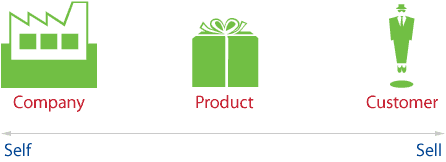The best copywriting focuses on your customer, not your company
It’s important to focus on benefits in copywriting – the good things that will happen for customers as a result of using the product or service in question. Another way to think about this is in terms of where the copy is focused: on the company, the product, or the customer.
Imagine a conversation between the company and the customer. They are talking over a table, and on the table is the product being sold. It’s a fairly one-sided conversation – the company is doing the talking, and the customer is listening. When the company has finished talking, the customer will decide whether or not to buy. This is what happens when customer encounters marketing copy.
Now imagine a line stretching from the company through the product and on to the customer. This is shown below (apologies for the terrible, terrible icons):

- Purely selfish copy is all about the company: how long it’s been trading, who runs it, where it’s located, its principles and vision. Unless these points can be translated into benefits (a particular location, for example, could help customers access the product) they’ve got no place in marketing copy. This is the stuff that goes in ‘About us’ on websites, so people can easily avoid it. Some company facts do constitute indirect reasons to buy – being a market leader, for example, is compelling – but most don’t.
- Slightly less selfish is stuff on the business/product boundary – how a product was developed, the thinking behind it and so on. This might add some value, but it’s background at best.
- Material on the product itself is good, but remember that a straightforward factual description will only sell to those who are already very clear about what they want and why. However, this content is ready to be re-expressed as customer benefits in order to sell harder.
- Copy about the interface between product and customer concerns how the product can be bought, how and when it’s used, what it does and so on. This is where customer benefits begin to enter the picture, particularly if the text explains why the various attribute are good.
- Finally, and most powerfully, we come to copy that focuses purely on the customer. This content starts with customer concerns and goes on to explain how the product will help them, in words they’ll understand. Effective copywriting spends most of its time here.
Companies who produce their own copy often start with themselves and the product. That’s perfectly understandable for people who are closely involved, but it highlights the importance of getting a fresh perspective on the text. As a newcomer and an outsider, the copywriter’s job is to move the emphasis to the customer by (politely) asking questions such as:
- How does that help me as a customer?
- How does that affect my decision to buy, or not to buy?
- As a potential customer, why should I be interested?
Any points that are too company- or product-focused should be recast in terms of things the customer wants, or failing that deleted. The end result should be text that talks directly to the customer’s own priorities, linking them clearly to the product. To confirm that this is so, compare the number of times you’ve said ‘you’ as opposed to ‘we’ or ‘us’. There should be at least twice as many mentions of the customer as of the company.
Marketing may be a one-way communication, but as with any other conversation, acknowledging the other person’s point of view is more likely to get positive results.
Comments (2)
Comments are closed.
I totally agree Tom, content needs to be well writen and have a clear and focused mesage across your whole site. With all the new content going live on websites every day, you have to ensure that when (and if) people find your site, that you fully engage with them or you stand no chance of making a sale.
An example would be a supermarket putting out of date or unpopular products by the main enterence for people to see from outside. What message would that sent to its customers about its store and products?
You have about 8 seconds to engage with new users who find your site, so you need make every one of them count. If it boring or off topic, would you read on? I know I don’t.
[…] corporate chest-beating (Exxon’s above being an egocentric boast par excellence). And because the best copywriting focuses on the customer, not the company, that’s probably best avoided. You want your tagline to leave at least some space for your […]